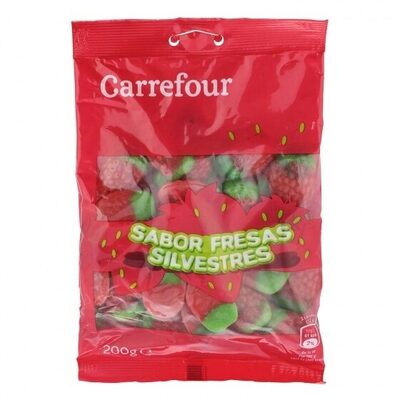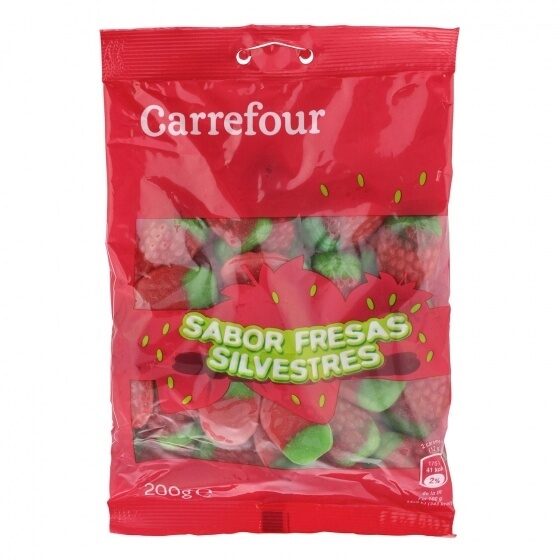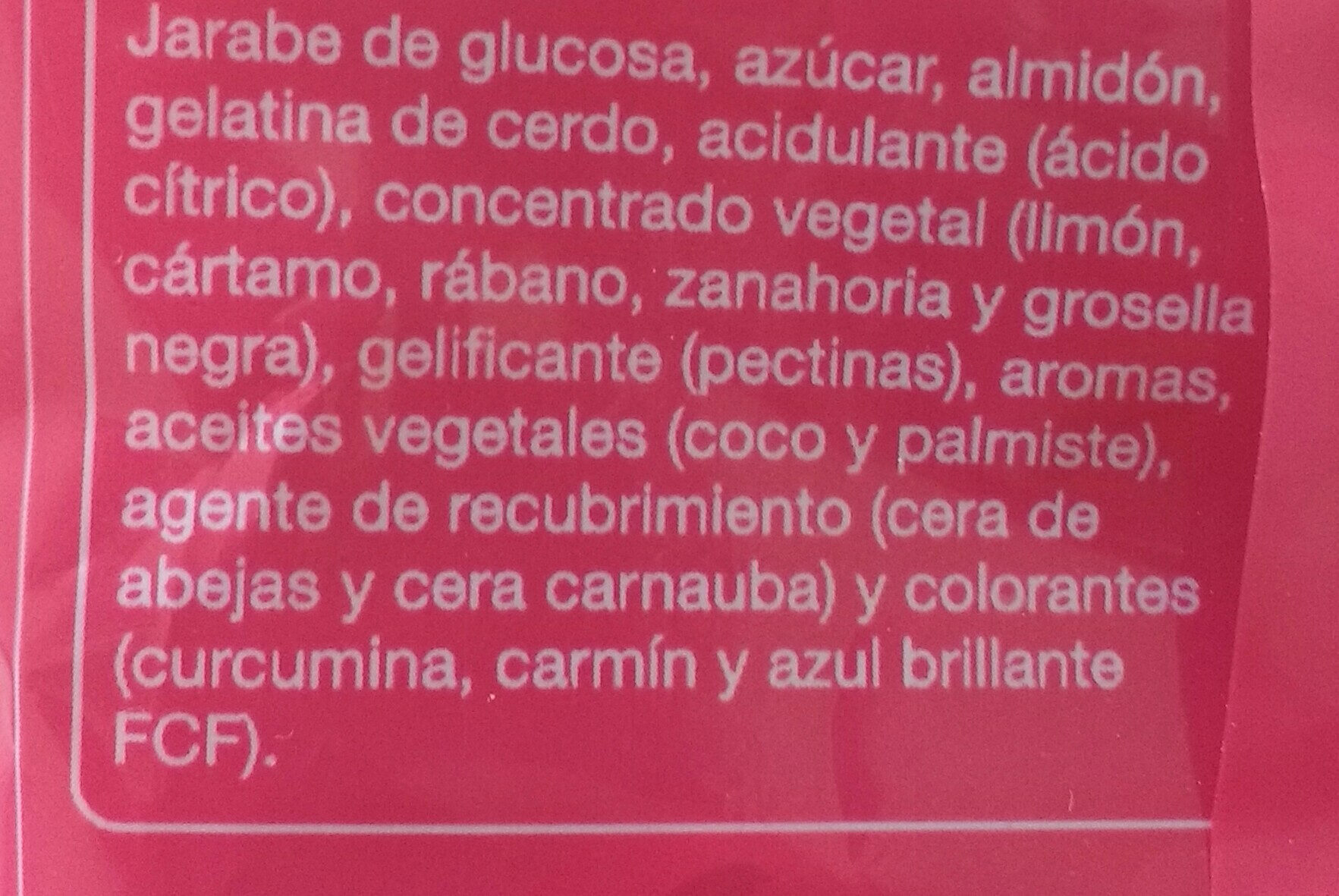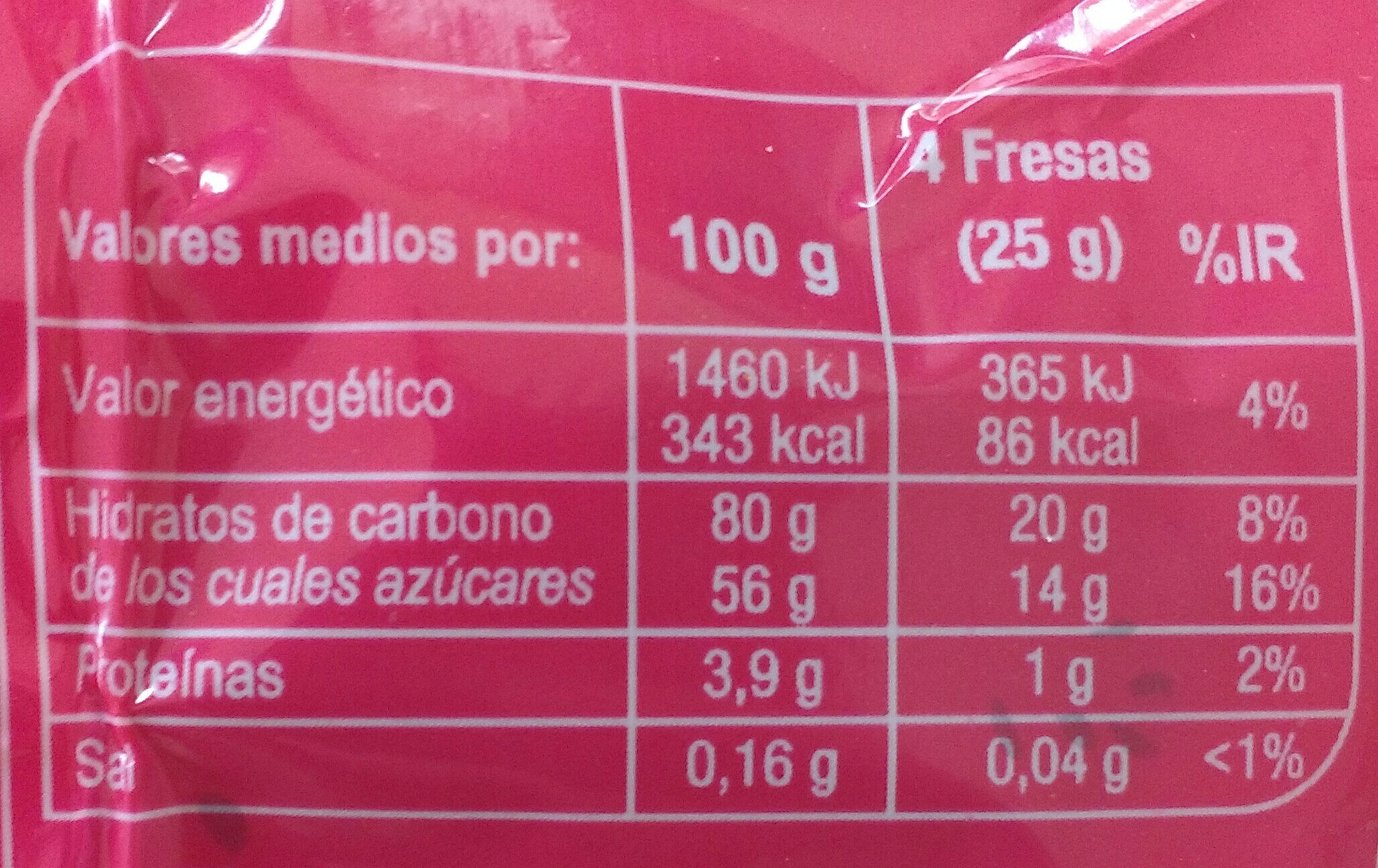Help us make food transparency the norm!
As a non-profit organization, we depend on your donations to continue informing consumers around the world about what they eat.
The food revolution starts with you!
Caramelo goma fresas silvestres - Carrefour - 200 g
Caramelo goma fresas silvestres - Carrefour - 200 g
This product page is not complete. You can help to complete it by editing it and adding more data from the photos we have, or by taking more photos using the app for Android or iPhone/iPad. Thank you!
×
Some of the data for this product has been provided directly by the manufacturer Carrefour España.
Barra-kodea: 3560070466214 (EAN / EAN-13)
Kopurua: 200 g
Ontziratzea: en:Bag
Markak: Carrefour
Kategoriak: en:Snacks, en:Sweet snacks, en:Confectioneries, en:Candies, en:Gummi candies
Dendak: Carrefour
Saltzen diren herrialdeak: Espainia
Matching with your preferences
Health
Osagaiak
-
25 ingredients
: Jarabe de glucosa, azúcar, almidón de maíz, gelatina, acidulante (ácido cítrico), concentrado vegetal (limón, cártamo, rábano, zanahoria, grosella negra), gelificante (pectinas), aromas, aceites vegetales (coco, palmiste), agente de recubrimiento (cera de abejas, cera carnauba), colorantes (curcumina, carmines, azul brillante FCF).Alergenoak: es:ausencia
Food processing
-
Ultra processed foods
Elements that indicate the product is in the 4 - Ultra prozesatutako elikagaiak eta edariak group:
- Gehigarria: E100
- Gehigarria: E120 - Gorrimin
- Gehigarria: E133
- Gehigarria: E428 - Gelatina
- Gehigarria: E440 - Pektina
- Gehigarria: E901 - Erle-argizari
- Gehigarria: E903
- Osagaia: Colour
- Osagaia: Flavouring
- Osagaia: Gelling agent
- Osagaia: Glazing agent
- Osagaia: Glukosa
- Osagaia: Almibar
Food products are classified into 4 groups according to their degree of processing:
- Prozesatu gabeko edo ahalik eta gutxien prozesatutako elikagaiak
- Sukaldaritzako osagaiak prozesatu
- Prozesatutako jakiak
- Ultra processed foods
The determination of the group is based on the category of the product and on the ingredients it contains.
Gehigarriak
-
E120 - Gorrimin
Carminic acid: Carminic acid -C22H20O13- is a red glucosidal hydroxyanthrapurin that occurs naturally in some scale insects, such as the cochineal, Armenian cochineal, and Polish cochineal. The insects produce the acid as a deterrent to predators. An aluminum salt of carminic acid is the coloring agent in carmine. Synonyms are C.I. 75470 and C.I. Natural Red 4. The chemical structure of carminic acid consists of a core anthraquinone structure linked to a glucose sugar unit. Carminic acid was first synthesized in the laboratory by organic chemists in 1991.Source: Wikipedia (Ingeles)
-
E133
Brilliant Blue FCF: Brilliant Blue FCF -Blue 1- is an organic compound classified as a triarylmethane dye and a blue azo dye, reflecting its chemical structure. Known under various commercial names, it is a colorant for foods and other substances. It is denoted by E number E133 and has a color index of 42090. It has the appearance of a blue powder. It is soluble in water, and the solution has a maximum absorption at about 628 nanometers.Source: Wikipedia (Ingeles)
-
E330 - Azido zitriko
Citric acid: Citric acid is a weak organic acid that has the chemical formula C6H8O7. It occurs naturally in citrus fruits. In biochemistry, it is an intermediate in the citric acid cycle, which occurs in the metabolism of all aerobic organisms. More than a million tons of citric acid are manufactured every year. It is used widely as an acidifier, as a flavoring and chelating agent.A citrate is a derivative of citric acid; that is, the salts, esters, and the polyatomic anion found in solution. An example of the former, a salt is trisodium citrate; an ester is triethyl citrate. When part of a salt, the formula of the citrate ion is written as C6H5O3−7 or C3H5O-COO-3−3.Source: Wikipedia (Ingeles)
-
E440 - Pektina
Pectin: Pectin -from Ancient Greek: πηκτικός pēktikós, "congealed, curdled"- is a structural heteropolysaccharide contained in the primary cell walls of terrestrial plants. It was first isolated and described in 1825 by Henri Braconnot. It is produced commercially as a white to light brown powder, mainly extracted from citrus fruits, and is used in food as a gelling agent, particularly in jams and jellies. It is also used in dessert fillings, medicines, sweets, as a stabilizer in fruit juices and milk drinks, and as a source of dietary fiber.Source: Wikipedia (Ingeles)
-
E901 - Erle-argizari
Beeswax: Beeswax -cera alba- is a natural wax produced by honey bees of the genus Apis. The wax is formed into "scales" by eight wax-producing glands in the abdominal segments of worker bees, which discard it in or at the hive. The hive workers collect and use it to form cells for honey storage and larval and pupal protection within the beehive. Chemically, beeswax consists mainly of esters of fatty acids and various long-chain alcohols. Beeswax has long-standing applications in human food and flavoring. For example, it is used as a glazing agent or as a light/heat source. It is edible, in the sense of having similar negligible toxicity to plant waxes, and is approved for food use in most countries and the European Union under the E number E901. However, the wax monoesters in beeswax are poorly hydrolysed in the guts of humans and other mammals, so they have insignificant nutritional value. Some birds, such as honeyguides, can digest beeswax. Beeswax is the main diet of wax moth larvae.Source: Wikipedia (Ingeles)
-
E903
Carnauba wax: Carnauba -; Portuguese: carnaúba [kaʁnɐˈubɐ]-, also called Brazil wax and palm wax, is a wax of the leaves of the palm Copernicia prunifera -Synonym: Copernicia cerifera-, a plant native to and grown only in the northeastern Brazilian states of Piauí, Ceará, Maranhão, Bahia, and Rio Grande do Norte. It is known as "queen of waxes" and in its pure state, usually comes in the form of hard yellow-brown flakes. It is obtained from the leaves of the carnauba palm by collecting and drying them, beating them to loosen the wax, then refining and bleaching the wax.Source: Wikipedia (Ingeles)
Ingredients analysis
-
en:Palm oil
Ingredients that contain palm oil: Palmiste olio
-
en:Non-vegan
Non-vegan ingredients: E428, E901, E120
-
en:Non-vegetarian
Non-vegetarian ingredients: E428, E120
-
Details of the analysis of the ingredients
: Jarabe de glucosa, azúcar, almidón de maíz, gelatina, acidulante (ácido cítrico), concentrado vegetal (limón, cártamo, rábano, zanahoria, grosella negra), gelificante (pectinas), aromas, aceites vegetales (coco, palmiste), agente de recubrimiento (cera de abejas, cera carnauba), colorantes (curcumina, carmines, azul brillante FCF)- Jarabe de glucosa -> en:glucose-syrup - vegan: yes - vegetarian: yes - ciqual_proxy_food_code: 31016 - percent_min: 9.09090909090909 - percent_max: 100
- azúcar -> en:sugar - vegan: yes - vegetarian: yes - ciqual_proxy_food_code: 31016 - percent_min: 0 - percent_max: 50
- almidón de maíz -> en:corn-starch - vegan: yes - vegetarian: yes - ciqual_food_code: 9510 - percent_min: 0 - percent_max: 33.3333333333333
- gelatina -> en:e428 - vegan: no - vegetarian: no - percent_min: 0 - percent_max: 25
- acidulante -> en:acid - percent_min: 0 - percent_max: 20
- ácido cítrico -> en:e330 - vegan: yes - vegetarian: yes - percent_min: 0 - percent_max: 20
- concentrado vegetal -> en:vegetable-concentrate - vegan: yes - vegetarian: yes - percent_min: 0 - percent_max: 16.6666666666667
- limón -> en:lemon - vegan: yes - vegetarian: yes - ciqual_proxy_food_code: 13009 - percent_min: 0 - percent_max: 16.6666666666667
- cártamo -> en:safflower - vegan: yes - vegetarian: yes - percent_min: 0 - percent_max: 8.33333333333333
- rábano -> en:radish - vegan: yes - vegetarian: yes - ciqual_food_code: 20045 - percent_min: 0 - percent_max: 5.55555555555556
- zanahoria -> en:carrot - vegan: yes - vegetarian: yes - ciqual_food_code: 20009 - percent_min: 0 - percent_max: 4.16666666666667
- grosella negra -> en:blackcurrant - vegan: yes - vegetarian: yes - ciqual_food_code: 13007 - percent_min: 0 - percent_max: 3.33333333333333
- gelificante -> en:gelling-agent - percent_min: 0 - percent_max: 14.2857142857143
- pectinas -> en:e440a - vegan: yes - vegetarian: yes - percent_min: 0 - percent_max: 14.2857142857143
- aromas -> en:flavouring - vegan: maybe - vegetarian: maybe - percent_min: 0 - percent_max: 5
- aceites vegetales -> en:vegetable-oil - vegan: yes - vegetarian: yes - from_palm_oil: maybe - percent_min: 0 - percent_max: 5
- coco -> en:coconut - vegan: yes - vegetarian: yes - ciqual_proxy_food_code: 15006 - percent_min: 0 - percent_max: 5
- palmiste -> en:palm-kernel-oil - vegan: yes - vegetarian: yes - from_palm_oil: yes - percent_min: 0 - percent_max: 2.5
- agente de recubrimiento -> en:glazing-agent - percent_min: 0 - percent_max: 5
- cera de abejas -> en:e901 - vegan: no - vegetarian: yes - percent_min: 0 - percent_max: 5
- cera carnauba -> en:e903 - vegan: yes - vegetarian: yes - percent_min: 0 - percent_max: 2.5
- colorantes -> en:colour - percent_min: 0 - percent_max: 5
- curcumina -> en:e100 - vegan: yes - vegetarian: yes - percent_min: 0 - percent_max: 5
- carmines -> en:e120 - vegan: no - vegetarian: no - percent_min: 0 - percent_max: 2.5
- azul brillante FCF -> en:e133 - vegan: yes - vegetarian: yes - percent_min: 0 - percent_max: 1.66666666666667
Elikadura
-
Poor nutritional quality
This product is not considered a beverage for the calculation of the Nutri-Score.
Positive points: 0
- Proteinak: 2 / 5 (balioa: 4, rounded value: 4)
- Fiber: 0 / 5 (balioa: 0, rounded value: 0)
- Fruits, vegetables, nuts, and colza/walnut/olive oils: 0 / 5 (balioa: 0, rounded value: 0)
Negative points: 14
- Energia: 4 / 10 (balioa: 1459, rounded value: 1459)
- Azukreak: 10 / 10 (balioa: 56, rounded value: 56)
- Gantz saturatua: 0 / 10 (balioa: 0.2, rounded value: 0.2)
- Sodioa: 0 / 10 (balioa: 56, rounded value: 56)
The points for proteins are not counted because the negative points are greater or equal to 11.
Nutritional score: (14 - 0)
Nutri-Score:
-
Nutrient levels
-
Koipe in low quantity (0.2%)
What you need to know- A high consumption of fat, especially saturated fats, can raise cholesterol, which increases the risk of heart diseases.
Recommendation: Limit the consumption of fat and saturated fat- Choose products with lower fat and saturated fat content.
-
Gantz-azido ase in low quantity (0.2%)
What you need to know- A high consumption of fat, especially saturated fats, can raise cholesterol, which increases the risk of heart diseases.
Recommendation: Limit the consumption of fat and saturated fat- Choose products with lower fat and saturated fat content.
-
Azukre in high quantity (56%)
What you need to know- A high consumption of sugar can cause weight gain and tooth decay. It also augments the risk of type 2 diabetes and cardio-vascular diseases.
Recommendation: Limit the consumption of sugar and sugary drinks- Sugary drinks (such as sodas, fruit beverages, and fruit juices and nectars) should be limited as much as possible (no more than 1 glass a day).
- Choose products with lower sugar content and reduce the consumption of products with added sugars.
-
Gatz arrunt in low quantity (0.14%)
What you need to know- A high consumption of salt (or sodium) can cause raised blood pressure, which can increase the risk of heart disease and stroke.
- Many people who have high blood pressure do not know it, as there are often no symptoms.
- Most people consume too much salt (on average 9 to 12 grams per day), around twice the recommended maximum level of intake.
Recommendation: Limit the consumption of salt and salted food- Reduce the quantity of salt used when cooking, and don't salt again at the table.
- Limit the consumption of salty snacks and choose products with lower salt content.
-
-
Nutrition facts
Nutrition facts As sold
for 100 g / 100 mlCompared to: en:Gummi candies Energia 1.459 kj
(343 kcal)+% 3 Koipe 0,2 g -% 57 Gantz-azido ase 0,2 g -% 16 Carbohydrates 80 g - Azukre 56 g -% 0 Fiber 0 g -% 100 Proteina 4 g +% 18 Gatz arrunt 0,14 g +% 4 Fruits‚ vegetables‚ nuts and rapeseed‚ walnut and olive oils 0 % Fruits‚ vegetables‚ nuts and rapeseed‚ walnut and olive oils (estimate from ingredients list analysis) 1,509 %
Ingurumena
-
Eco-Score B - Ingurumen-eragin txikia
The Eco-Score is an experimental score that summarizes the environmental impacts of food products.→ The Eco-Score was initially developped for France and it is being extended to other European countries. The Eco-Score formula is subject to change as it is regularly improved to make it more precise and better suited to each country.Life cycle analysis
-
Average impact of products of the same category: A (Score: 89/100)
Kategoria: Jelly candy
Kategoria: Jelly candy
- PEF environmental score: 0.21 (the lower the score, the lower the impact)
- including impact on climate change: 1.57 kg CO2 eq/kg of product
Stage Impact Agriculture
51.7 %Processing
31.1 %Ontziratzea
7.6 %Transportation
7.3 %Distribution
2.3 %Consumption
0.0 %
Bonuses and maluses
-
Missing origins of ingredients information
Malus: -5
⚠ ️ The origins of the ingredients of this product are not indicated.
If they are indicated on the packaging, you can modify the product sheet and add them.
If you are the manufacturer of this product, you can send us the information with our free platform for producers.
-
Ingredients that threatens species
Malus: -10
Contains palm oil
Tropical forests in Asia, Africa and Latin America are destroyed to create and expand oil palm tree plantations. The deforestation contributes to climate change, and it endangers species such as the orangutan, the pigmy elephant and the Sumatran rhino.
-
Packaging with a medium impact
Malus: -10
Shape Material Recycling Impact Bag Unknown Altua ⚠ ️ The information about the packaging of this product is not sufficiently precise (exact shapes and materials of all components of the packaging).⚠ ️ For a more precise calculation of the Eco-Score, you can modify the product page and add them.
If you are the manufacturer of this product, you can send us the information with our free platform for producers.
Eco-Score for this product
-
Impact for this product: B (Score: 64/100)
Produktua: Caramelo goma fresas silvestres - Carrefour - 200 g
Life cycle analysis score: 89
Sum of bonuses and maluses: -25
Final score: 64/100
-
Carbon footprint
-
Equal to driving 0.8 km in a petrol car
157 g CO² per 100g of product
The carbon emission figure comes from ADEME's Agribalyse database, for the category: Jelly candy (Source: ADEME Agribalyse Database)
Stage Impact Agriculture
36.9 %Processing
38.1 %Ontziratzea
11.9 %Transportation
12.0 %Distribution
1.1 %Consumption
0.0 %
Ontziratzea
-
Packaging with a medium impact
-
Packaging parts
Bag
-
Bilgarriaren materialak
Material % Bilgarriaren pisua Bilgarriaren pisua produktuaren 100g-ko
-
Transportation
-
Origins of ingredients
Missing origins of ingredients information
⚠ ️ The origins of the ingredients of this product are not indicated.
If they are indicated on the packaging, you can modify the product sheet and add them.
If you are the manufacturer of this product, you can send us the information with our free platform for producers.Add the origins of ingredients for this product Add the origins of ingredients for this product
Threatened species
-
Contains palm oil
Drives deforestation and threatens species such as the orangutan
Tropical forests in Asia, Africa and Latin America are destroyed to create and expand oil palm tree plantations. The deforestation contributes to climate change, and it endangers species such as the orangutan, the pigmy elephant and the Sumatran rhino.
Report a problem
-
Incomplete or incorrect information?
Category, labels, ingredients, allergens, nutritional information, photos etc.
If the information does not match the information on the packaging, please complete or correct it. Open Food Facts is a collaborative database, and every contribution is useful for all.
Datuen iturria
Product added on by saisa
Last edit of product page on by packbot.
Produktuaren orria -gatik editatua fix-salt-bot, kiliweb, openfoodfacts-contributors, org-carrefour-espana, roboto-app, teolemon, thaialagata, yuka.UzdwZks2b3FyY01JZy9ZNzMwdjM0ZnRyN2JhelVVQ1hMZllOSVE9PQ, yuka.VGI0aEFhQUZqNlFBZ05nZTFVN295djFsMzV5a2R6K3pjc3RPSVE9PQ.










